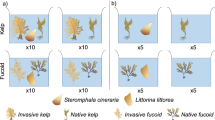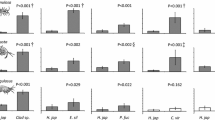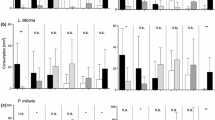Abstract
Generalist consumers potentially limit introduced prey populations when they are willing and able to consume those prey, but because generalist consumers vary in feeding preference, they are not equally effective in resisting invasions. Previous work suggested that during the introduction of the red seaweed Gracilaria vermiculophylla to North American and European shorelines, populations evolved enhanced levels of constitutive and activated prostaglandin-based defenses against Littorina snails and the isopod Idotea balthica. However, when we offered tissue from a total of 700 G. vermiculophylla thalli from 14 native Japanese and 25 non-native sites to a North American population of the generalist amphipod Ampithoe valida, native and non-native populations were consumed at statistically indistinguishable rates. In contrast to previous results using Idotea and Littorina, we found no evidence that mechanical wounding of G. vermiculophylla altered palatability of thalli to A. valida. These results indicate either the strength of anti-herbivore defense varies across the geographic range in the seaweed’s native range in the Northwest Pacific, that the effectiveness of G. vermiculophylla to deter herbivores varies across generalist herbivore species, or both. In either case, we question the conclusion that rapid phenotypic shift in anti-herbivory traits to generalist herbivores occurred in this species. Future studies should focus on whether shifts in anti-herbivore defenses are adaptive by experimentally assessing species-specific herbivore impacts in native and non-native ranges.



Similar content being viewed by others
References
Cacabelos E, Olabarria C, Inera M, Troncoso JS (2010) Do grazers prefer invasive seaweeds? J Exp Mar Biol 393:182–187
Colautti RI, Lau JA (2015) Contemporary evolution during invasion: evidence for differentiation, natural selection, and local adaptation. Mol Ecol 24:1999–2017
Colautti RI, Ricciardi A, Grigorovich IA, MacIsaac HJ (2004) Is invasion success explained by the enemy release hypothesis? Ecol Lett 7:721–733
Cruz-Rivera E, Hay ME (2000) The effects of diet mixing on consumer fitness: macroalgae, epiphytes, and animal matter as food for marine amphipods. Oecologia 123:252–264
Enge S, Nylund GM, Harder T, Pavia H (2012) An exotic chemical weapon explains low herbivore damage in an invasive alga. Ecology 93:2736–2745
Engelen AH, Henriques N, Monteiro C, Santos R (2011) Mesograzers prefer mostly native seaweeds over the invasive brown seaweed Sargassum muticum. Hydrobiologia 669:157–165
Felker-Quinn E, Schweitzer JA, Bailey JK (2013) Meta-analysis reveals evolution in invasive plant species but little support for evolution of increased competitive ability (EICA). Ecol Evol 3:739–751
Forslund H, Wikström SA, Pavia H (2010) Higher resistance to herbivory in introduced compared to native populations of a seaweed. Oecologia 164:833–840
Hammann M, Wang G, Rickert E, Boo SM, Weinberger F (2013) Invasion success of the seaweed Gracilaria vermiculophylla correlates with low palatibility. Mar Ecol Prog Ser 486:93–103
Hammann M, Rempt M, Pohnert G, Wang G, Boo SM, Weinberger F (2016) Increased potential for wound activated production of Prostaglandin E2 and related toxic compounds in non-native populations of Gracilaria vermiculophylla. Harmful Algae 51:81–88
Hierro JL, Maron JL, Callaway RM (2005) A biogeographical approach to plant invasions: the importance of studying exotics in their introduced and native range. J Ecol 93:5–15
Hufbauer R, Facon B, Ravigne V (2012) Anthropogenically induced adaptation to invade (AIAI): contemporary adaptation to human-altered habitats within the native range can promote invasions. Evol Appl 5:89–101
Keane RM, Crawley MJ (2002) Exotic plant invasions and the enemy release hyputhesis. Trends Ecol Evol 17:164–170
Kollars NM, Krueger-Hadfield SA, Byers JE, Greig TW, Strand AE, Weinberger F, Sotka EE (2015) Development and characterization of microsatellite loci for the haploid–diploid red seaweed Gracilaria vermiculophylla. PeerJ 3:e1159
Kooyers NJ, Olsen KM (2012) Rapid evolution of an adaptive cyanogenesis cline in introduced North American white clover (Trifolium repens L.). Mol Ecol 21:2455–2468
Krueger-Hadfield SA, Kollars NM, Byers JE, Greig TW, Hammann M, Murray DC, Murren CJ, Strand AE, Terada R, Weinberger F, Sotka EE (2016) Invasion of novel habitats uncouples haplo-diplontic life cycles. Mol Ecol 25:3801–3816
Krueger-Hadfield SA, Kollars N, Strand A, Byers J, Shainker S, Terada R, Greig T, Hammann M, Murray D, Weinberger F, Sotka EE (2017) The identification of source and vector of a widespread marine invader. Ecol Evol 7:4432–4447
Kuznetsova A, Brockhoff PB, Christensen RHB (2016) lmerTest: tests in linear mixed effects models. R package version 2.0-33
Lind EM, Parker JD (2010) Novel weapons testing: are invasive plants more chemically defended than native plants? PLoS One 5(5):e10429
Maggi E, Castelli A, Chatzinikolaou E, Ghedini G (2015) Ecological impacts of invading seaweeds: a meta-analysis of their effects at different trophic levels. Divers Distrib 21:1–12
Monteiro CA, Engelen AH, Santos ROP (2009) Macro- and mesoherbivores prefer native seaweeds over the invasive brown seaweed Sargassum muticum: a potential regulating role on invasions. Mar Biol 156:2505–2515
Müller-Schärer H, Schaffner U, Steinger T (2004) Evolution in invasive plants: implications for biological control. Trends Ecol Evol 19:417–422
Nejrup LB, Pedersen MF (2012) The effect of temporal variability in salinity on the invasive red alga Gracilaria vermiculophylla. Eur J Phycol 47:254–263
Nyberg CD, Wallentinus I (2005) Can species traits be used to predict marine macroalgal introductions? Biol Invasions 7:265–279
Nylund GM, Weinberger F, Rempt M, Pohnert G (2011) Metabolomic assessment of induced and activated chemical defence in the invasive red alga Gracilaria vermiculophylla. PLoS One 6(12):e29359
Parker JD, Burkepile DE, Hay ME (2006) Opposing effects of native and exotic. Science 311:1459–1461
Pilgrim EM, Darling JA (2010) Genetic diversity in two introduced biofouling amphipods (Ampithoe valida & Jassa marmorata) along the Pacific North American coast: investigation into molecular identification and cryptic diversity. Divers Distrib 16:827–839
R Core Team (2017) R: a language and environment for statistical computing. R Foundation for Statistical Computing, Vienna, Austria. https://www.R-project.org/
Raikar SV, Iima M, Fujita Y (2001) Effect of temperature, salinity and light intensity on the growth of Gracilaria spp. (Gracilariales, Rhodophyta) from Japan, Malaysia and India. Indian J Mar Sci 30:98–104
Reynolds LK, Carr LA, Boyer KE (2012) A non-native amphipod consumes eelgrass inflorescences in San Francisco Bay. Mar Ecol Press Ser 451:107–118
Rueness J (2005) Life history and molecular sequences of Gracilaria vermiculophylla (Gracilariales, Rhodophyta), a new introduction to European waters. Phycologia 44:120–128
Sakai AK, Allendorf FW, Holt JS, Lodge DM, Molofsky J, With KA, Baughman S, Cabin RJ, Cohen JE, Ellstrand NC, Mccauley DE, O’Neil PO, Parker IM, Thompson JN, Weller SG (2001) The population biology of invasive species. Annu Rev Ecol Syst 32:305–332
Schneider CA, Rasband WS, Eliceiri KW (2012) NIH Image to ImageJ: 25 years of image analysis. Nat Methods 9:671–675
Schwartz N, Rohde S, Hiromori S, Schupp PJ (2016) Understanding the invasion success of Sargassum muticum: herbivore preferences for native and invasive Sargassum spp. Mar Biol 2016:163–181
Sotka EE, Forbey J, Horn M, Poore AGB, Raubenheimer D, Whalen KE (2009) The emerging role of pharmacology in understanding consumer—prey interactions in marine and freshwater systems. Integr Comp Biol 49:291–313
Sotka EE, Baumgardner AW, Bippus PM, Destombe C, Duermit EA, Endo H, Flanagan BA, Kamiya M, Lees LE, Murren CJ, Nakaoka M, Shainker SJ, Strand AE, Terada R, Valero M, Weinberger F, Krueger-Hadfield SA (2018) Combining niche-shift analysis and population genetics predicts rapid phenotypic evolution during invasion. Evol Appl (in press)
Sultan SE, Horgan-Kobelski T, Nichols LM, Riggs CE, Waples RK (2013) A resurrection study reveals rapid adaptive evolution within populations of an invasive plant. Evol Appl 6:266–278
Thornber CS (2006) Functional properties of the isomorphic biphasic algal life cycle. Integr Comp Biol 46:605–614
Tyberghein L, Verbruggen H, Pauly K, Troupin C, Mineur F, De Clerck O (2012) Bio-ORACLE: a global environmental dataset for marine species distribution modelling. Glob Ecol Biogeogr 21:272–281
Vila M, Espinar JL, Hejda M, Hulme PE, Jaro V, Maron JL, Pergl J, Schaffner U, Sun Y, Pyek P (2011) Ecological impacts of invasive alien plants: a meta-analysis of their effects on species, communities and ecosystems. Ecol Lett 14:702–708
Weinberger F, Buchholz B, Karez R, Wahl M (2008) The invasive red alga Gracilaria vermiculophylla in the Baltic Sea: adaptation to brackish water may compensate for light limitation. Aquat Biol 3:251–264
Wikström SA, Steinarsdottir MB, Kautsky L, Pavia H (2006) Increased chemical resistance explains low herbivore colonization of introduced seaweed. Oecologia 148:593–601
Yokoya NS, Kakita H, Obika H, Kitamura T (1999) Effects of environmental factors and plant growth regulators on growth of the red alga Gracilaria vermiculophylla from Shikoku Island, Japan. Hydrobiologia 398(399):339–347
Acknowledgements
This project was supported in part by a Student Undergraduate Research with Faculty grant from the College of Charleston and by NSF (OCE#1357386). Thank you to S.J. Shainker, B.A. Flanagan, L.E. Lees, A.W. Baumgardner, and E.A. Duermit for help with lab work, and M. Valero, C. Destombe, F. Weinberger, M. Nakaoka, H. Endo, M. Kamiya, R. Terada, C.J. Murren, and A.E. Strand and everyone else listed in Supplemental Table 1.
Funding
This study was funded by the National Science Foundation (OCE#1357386) and the College of Charleston.
Author information
Authors and Affiliations
Corresponding authors
Ethics declarations
Conflict of interest
All authors declare no conflict of interest.
Ethical approval
All applicable international, national, and/or institutional guidelines for the care and use of animals were followed.
Data accessibility
All experimental data underlying this publication are available from the FigShare depository (https://doi.org/10.6084/m9.figshare.5809323).
Additional information
Responsible Editor: F. Weinberger.
Reviewed by Undisclosed experts.
Electronic supplementary material
Below is the link to the electronic supplementary material.
227_2018_3291_MOESM1_ESM.pdf
Supplementary material 1 (PDF 22 kb) Supplemental Table 1: Population names, latitudes, sample size and collectors of all sites used in assays. Population names, latitudes, and collectors of all population sites used in assays. Populations are divided into five regions—two native and three introduced
Rights and permissions
About this article
Cite this article
Bippus, P.M., Krueger-Hadfield, S.A. & Sotka, E.E. Palatability of an introduced seaweed does not differ between native and non-native populations. Mar Biol 165, 39 (2018). https://doi.org/10.1007/s00227-018-3291-5
Received:
Accepted:
Published:
DOI: https://doi.org/10.1007/s00227-018-3291-5




